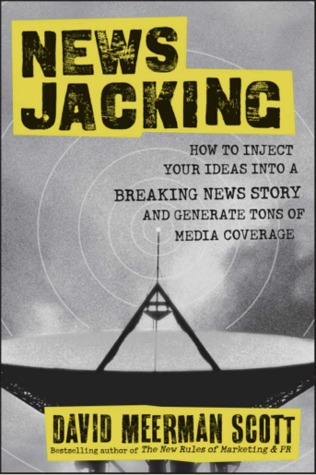More on this book
Kindle Notes & Highlights
Newsjacking: How to Inject your Ideas into a Breaking News Story and Generate Tons of Media Coverage
Newsjacking is powerful, but only when executed in real time. It is about taking advantage of opportunities that pop up for a fleeting moment, then disappear. In that instant, if you are clever enough to add a new dimension to the story in real time, the news media will write about you.
Why haven't you heard of newsjacking before? Because it is only since the emergence of the real-time web that newsjacking has become possible in a methodical, systematic fashion.
That's why the newsjacker's goal is to own the second paragraph. If you are clever enough to react to breaking news very quickly, providing credible second-paragraph content in a blog post, tweet, or media alert that features the keyword of the moment, you may be rewarded with a bonanza of media attention.
Your job is to instantly spot an angle and get it online—via your blog, Twitter, or media alert—as fast as you can. You need to be clever and quick. You need to operate in real time.
Create a comprehensive list of search terms relevant to your business or interests. Include anything that you might want to see become the second paragraph of a story related to your interests. Again, search for anything relevant: industry terms, competitors, customers, prospects, and products, plus any relevant buzzwords or phrases—every term you can think of.
Use a Twitter monitoring tool like TweetDeck or HootSuite to catch your key phrases.
When I worked in Tokyo in the 1980s, my journalist colleagues irreverently referred to the two economists who inevitably appeared in any story on Japan's economy as “the quote-whore twins.”
email to journalists who might be interested.
No matter what anyone might propose, in big business there are always grounds to oppose it.
I recommend drawing up a formal mandate—signed off by senior management, the PR department, and the legal department—that sets out rules of engagement in the same way that military commanders are empowered.
Comment on existing stories along with a link to your post.
If you have your own blog, you can also write a blog post that adds to a specific story, then link to it (using the names of both the reporter and the publication). Savvy reporters use Google Alerts (or other services) to track every mention of their names and publications. Again, the reporter will learn about your take on the story he or she just wrote.
if you find a story that you can add value to, simply contact the reporter directly.
Be dignified and statesmanlike.
Be upbeat and positive, never mean or vindictive.
Write articulate text in full sentences without chatty slang, industry jargon, corporate gobbledygook
Don't get too cute or clever—especially
Kenneth Cole ham-handedly attempted to insert his footwear brand into the Twitter conversation via the #Cairo hashtag that was the focal point for the uprising. Cole's tweet from his @KennethCole twitter ID: “Millions are in uproar in #Cairo. Rumor is they heard our new spring collection is now available online at http://bit.ly/KCairo - KC.” By trying to be cute and clever by including a hashtag used as a serious forum for millions of people who were in grave danger, Cole immediately generated a huge wave of negative response
When the marketers at Ragú pasta sauces kicked off a campaign focused on poking fun at the typical father's inability to cook, they tweeted from their @ragusauce account directly to men who frequently write about parenting. One target was C. C. Chapman, who runs Digital Dads. Chapman was offended by the campaign's stereotype because he considers himself a good cook. Chapman's blog post, “Ragu Hates Dads,” has been shared by nearly 2,000 people on Twitter and more than 900 on Facebook as I write this.
Flynt doesn't contact individual reporters, preferring to rely on journalists to find him through the search engines.
To newsjack is to inject your ideas into breaking news to generate media coverage. Newsjacking works best when a story is breaking, as journalists scramble for additional information to add to fast-developing news.


